Grapes are one of the most important crops in the world. Most grapes are grown for making wines, preparing raisins, and then as fresh fruit. The plant is primarily grown in India for table use. In Indian history, grape cultivation has been traced back to the Roman period, although the Caspian Sea is believed to have been the origin of grape cultivation.
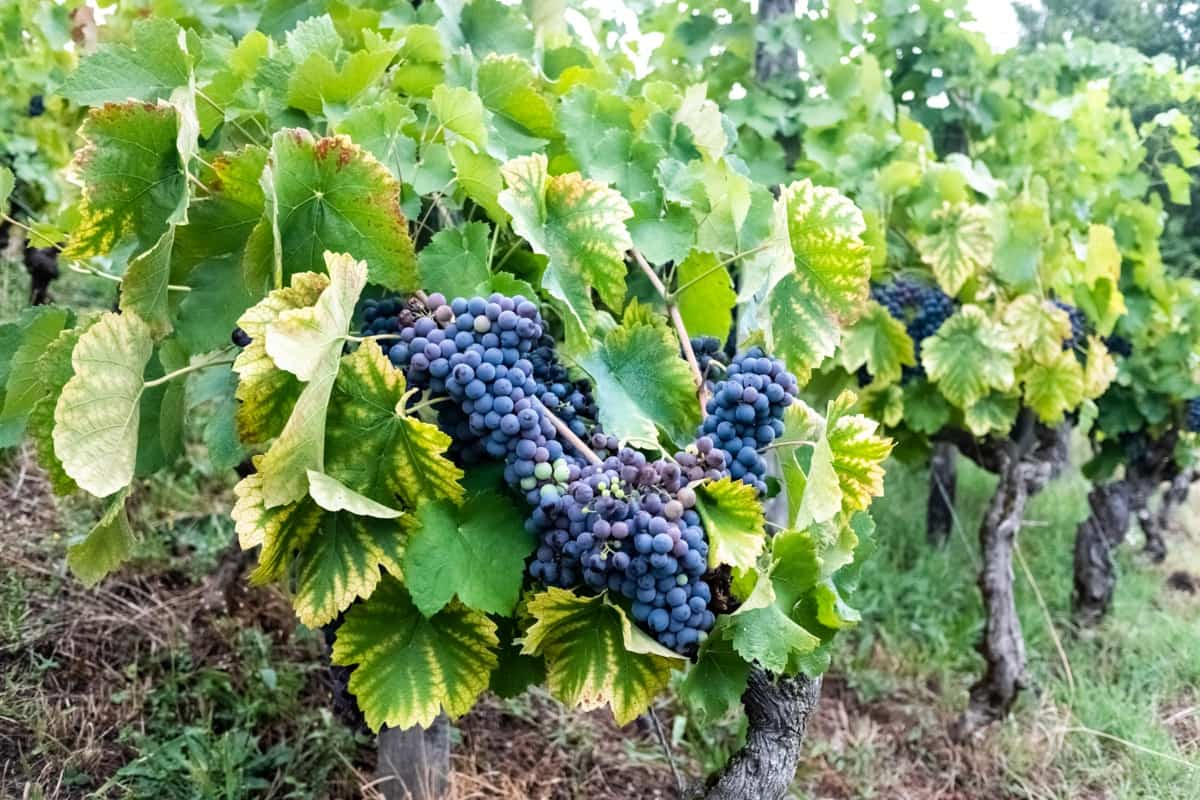
Maharashtra is the number one grape-producing state in India. Grape cultivation is prevalent in the state’s Nasik, Pune, Ahmednagar, Sangli, Osmanabad, Solapur, and Satara districts. After Maharashtra, the grape crop is widely produced in Karnataka’s Kolar, Bangalore, and Bijapur areas, as in the Rangareddy, Ananthapur, and Medak areas of Andhra Pradesh and Tamil Nadu.
How to grow grapes organically in Maharashtra
How the Maharashtra government supports organic farming
The state government has formulated a special policy for organic farming. According to the policy, a separate cell will be created at the district level to monitor organic farming in the area. Furthermore, the government has decided to promote brands by supporting and creating them. Organic farming is defined as using local natural resources and avoiding chemicals for cultivation in policy.
The scheme encourages farmers to use organic inputs to increase soil fertility, certified organic agricultural areas, sell organic products, brand organic agricultural products, and promote organic farming. The Maharashtra government is also promoting the production of organic crops, fruits, vegetables, etc., through various central government schemes viz,
In case you missed it: How to Control Pests and Diseases in Grapes: Causes, Symptoms, Chemical, and Biological Management
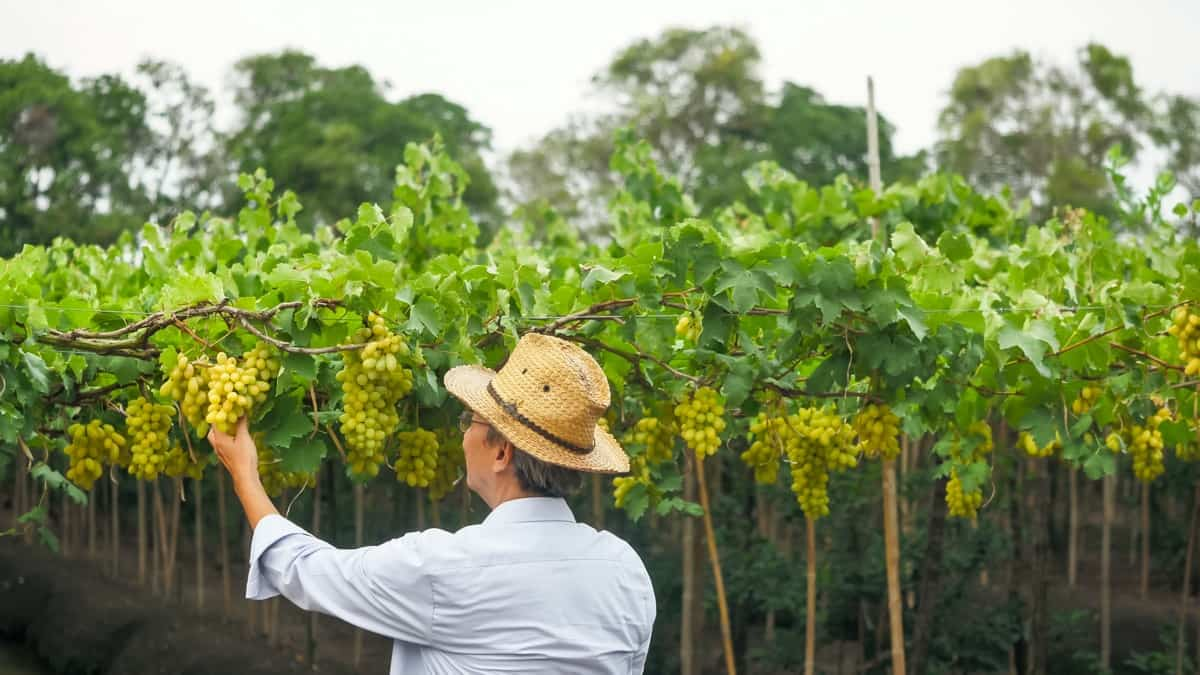
Paramparagat Krishi Vikas Yojana (PKVY)
With PGS (Participatory Guarantee System) certification, cluster-based organic farming is promoted as part of the Paramparagat Krishi Vikas Yojana. In addition to cluster formation, training, certification, and marketing, the scheme supports several other activities. Typically, farmers receive 20,000 rupees per acre per year, of which 60 percent (or 12,000 rupees) are applied to organic farming.
Mission Organic Value Chain Development for North Eastern Region (MOVCDNER)
Through Farmer Producer Organisations (FPOs), the scheme promotes third-party certified organic farming of niche crops in the northeast region. An organic input assistance program provides farmers Rs 10,000 per acre for three years, including organic manure and bio-fertilizers.
Bharatiya Prakritik Krishi Padhati (BPKP)
PKVY has initiated the Bharatiya Prakritik Krishi Padhati (BPKP) program to promote chemical-free farming with natural inputs. The program also supports individual farmers for certifications and continuous area certifications to bring in default organic areas.
Climatic requirements for Grape cultivation
Mediterranean climates are ideal for grape growing. The vines produce and grow in their natural habitat during the hot and dry seasons. The vines in South India produce vegetative growth between April and September, followed by fruiting between October and March. The quality and yield of crops are influenced by temperatures above 10°C to 40°C. There is a higher risk of fungal diseases when the humidity is high, and the weather is cloudy, in addition to lowering the ratio of T.S.S. to acid.
Soil requirements for Grape cultivation
Grapes can adjust to a wide range of soil conditions. Despite this, the highest yield and quality are achieved on soils with a pH range of 6.5 to 8.5, above 1.0% organic carbon content, are lime-free, and have a moderate water-holding capacity. Therefore, medium soils produce early but medium yields with a high TSS.
Grape varieties
| Grape type | Varieties |
| Colored seeded | Bangalore Blue Gulabi (Muscat) |
| Colored seedless | Beauty seedless Shared Seedless |
| White seeded | Anab-e-Shahi, Dilkhush (clone of Anab-e-Shahi) |
| White seedless | Perlette Pusa Seedless Thompson Seedless and its clones (Tas-A-Ganesh, Sonaka & Manik Chaman) |
In case you missed it: How to Start Grapes Farming in the USA: Production, and A Step-by-Step Growing Guide for Beginners
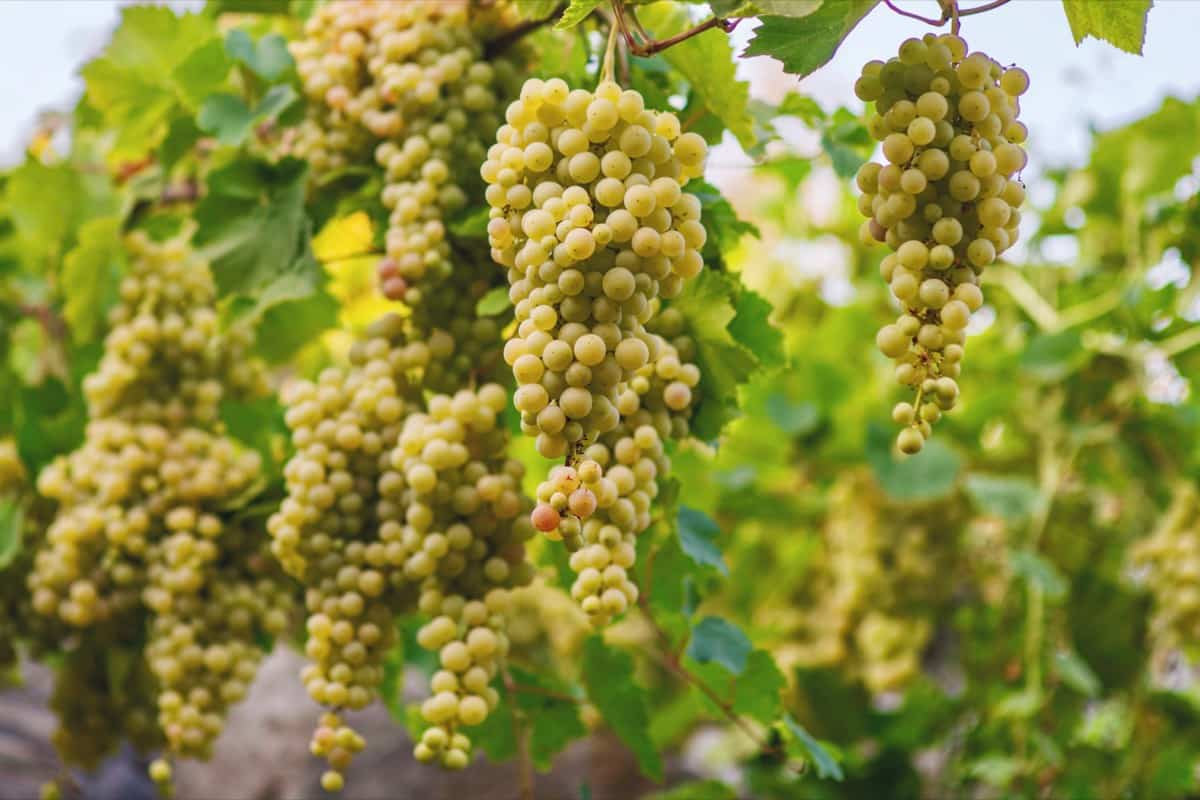
Field preparation and planting
Depending on the soil type, gradient, and requirement, the land is leveled by a tractor or bulldozer. It is not necessary to have perfect leveling when using drip irrigation. Pits are usually used to plant grape vines. The size of the pit depends on the spacing between the vines and the specific requirements of the variety. Depending on the soil type, the depth can range from 60 to 90 cm.
Nine to ten feet is the recommended spacing between rows. Irrigate copiously after filling the trenches with topsoil, F.Y.M., green manure, super phosphate, etc. About a month before planting, the pits need to be opened. When planting the table grapes, open the pits at the desired planting distance (5 to 6 feet). The rooted cuttings should be planted in the opened pits and irrigated immediately to prevent transplanting shock and field mortality.
During the rainy season, planting is usually avoided. Since the rainy season lasts until the end of November in Karnataka and Tamil Nadu, planting takes place from December-January. Depending on the season, plants begin to grow 10-15 days after planting. If you plant during the warm season, you will see growth earlier than during the cold season. Young plants need staking and training after one month of planting.
Irrigation requirements for Grape cultivation
Rainfall patterns, pruning times, growth stages, soil water-holding capacity, variety has grown, training methods and vine spacing affect irrigation practices in different regions of India. A small circular basin of a 50 cm radius provides irrigation once every three days to newly planted vineyards. The basin size increases to a radius of 2 meters with an increased growth rate. A drip irrigation system uses only one emitter at the vine’s base.
Depending on the variety and spacing of the vine, the number of emitters will gradually increase to two and then four. Irrigation is provided shortly after pruning to wet the entire root zone and stimulate active growth thoroughly. Light irrigation of 50-75mm is given every 10-12 days during winter and every 5-7 days during summer. The next irrigation is omitted or delayed in the event of rain during that interval. During the anthesis and fruiting stages, irrigation frequency is reduced after berry softening.
Organic fertilizers application in Grape farming
The type and the number of fertilizers required in a vineyard depend on many factors. The soil type, the age of the plant, the training system, the environmental conditions, the variety, and the type of vineyard, are all crucial factors. As a result, the plant has different nutrient requirements during development. The first application is performed at the end of winter (February).
In case you missed it: Growing Grapes In Greenhouse – Farming, Cultivation, Production In India
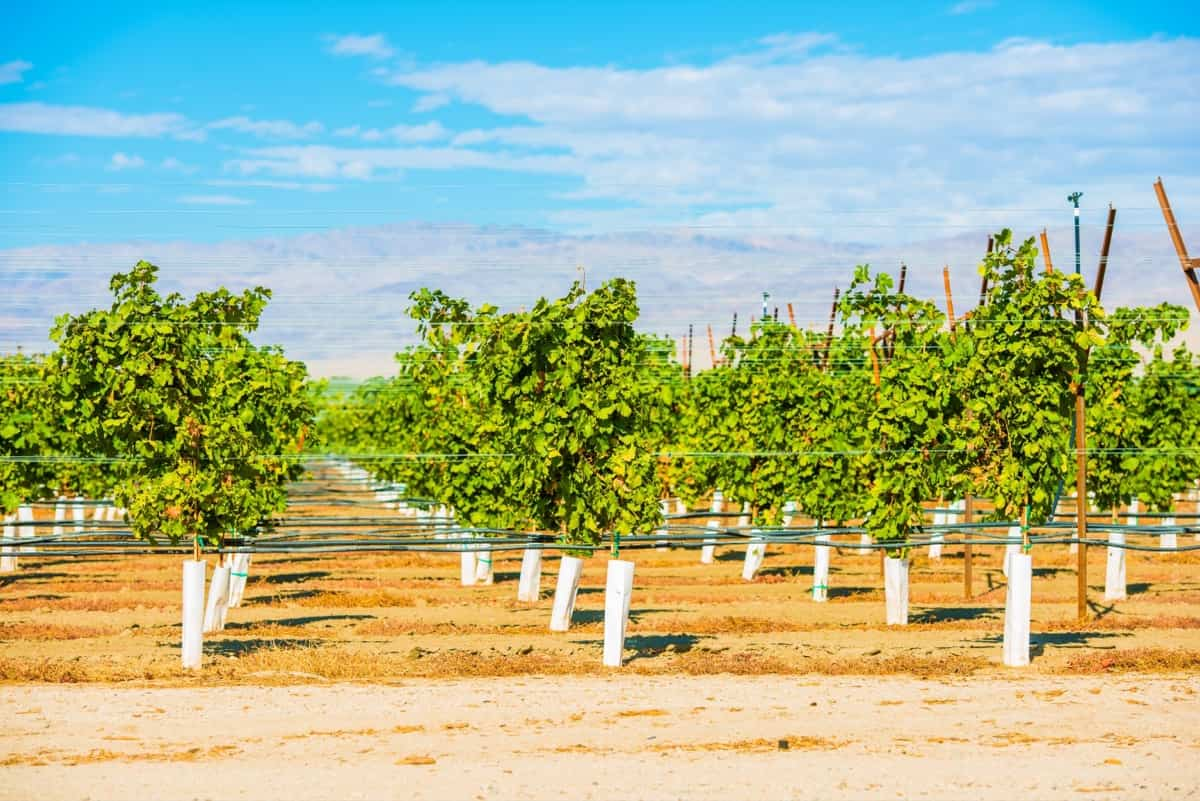
Many farmers apply well-rotted manure and plow well with a ripper. Like almost every other plant, Grapevines need nitrogen to jump-start rapid growth, especially in the spring. If you prefer manure to feed your vines, apply it in January or February. Apply 2-4.5 kg of poultry or rabbit manure or 2-9 kg of a steer or cow manure per vine.
Some farmers use seaweed extracts (Ascophyllum nodosum), while others apply nano-size Ca-based fertilization, especially on alkaline soil. A study revealed that applying nano-size Ca-based fertilizer led to remarkable enhancements in foliar development and chlorophyll concentration of the vines cultivated on alkaline soil. Applying Seaweed extracts also enhanced the leaf Zn chlorophyll content of the grapes.
Training Grape vines
Grapes can be trained in many ways, but the high cordon or high wire system is one of the best. To implement the high cordon method, Trellis posts must be eight feet long and buried two feet in the ground. The diameter of the end posts should be four to six inches, and the diameter of the posts within the row should be three inches.
There should be a seven- to eight-foot space between each grapevine. High-cordon systems have only one wire at the top. It would be best if you chose a wire that is 12.5 gauge high-tensile because grapevines must support a lot of weight. Establishing the plants the first year after planting your grapes would be best.
Rather than installing a permanent trellis, at least stake the new grapevine with a wooden or metal stake and tie it to it, so it grows straight. Then, when the vines have grown into woody canes about the size of a pencil, you can start training them. Two strong, healthy canes should be tied to the wire, one in each direction, using an elastic material such as a cloth, rubber band, or vinyl tape.
Pruning Grapevines
The best time to prune is between the start of dormancy and late February or the beginning of March, depending on your location. When pruning grapes, make sure they are fully dormant. A vine pruned too early might not be able to enter dormancy, which could result in cold injury. During the dormant season, pruning can protect the grapes for a shorter period from diseases such as grapevine cankers. In addition, those cuts will heal once the grapevine breaks dormancy.
In case you missed it: Organic Grapes Farming, Growing Practices
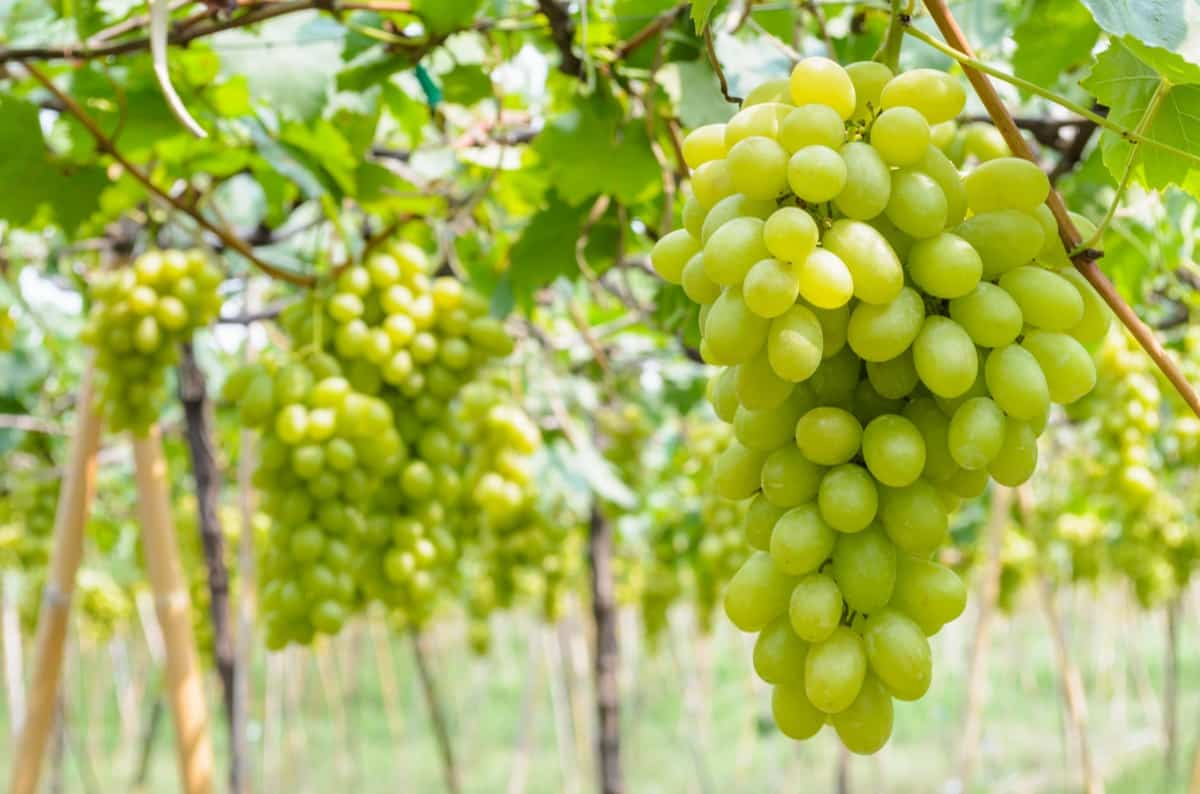
In addition to grape training, grape pruning can be intimidating since many different methods are available. The goal remains to remove 85 to 90 percent of all one-year-old wood. The amount of pruning you do depends on how vigorously your grapevines grow. Between cane pruning and spur pruning, cane pruning produces the best table grapes and the highest yields. Three-year-old or older grape vines can be pruned.
Pests in Grapes crop and their organic control
Mealybugs
Damage symptoms
- Honeydew excreted by mealybug nymphs and adults support the growth of sooty mold on leaves, shoots, and bunches
- Sooty and sticky bunches harboring mealybugs and their white cottony wax masses are unfit for marketing as table grapes.
- In case of severe mealybug infestation, young vines often die.
Control methods
- Neem-based, emulsifiable water-soluble formulations can be sprayed.
- Removal of weeds and alternate host plants like hibiscus, okra, custard apple, guava, and nearby vineyards throughout the year
Thrips
Damage symptoms
- Nymphs and adults cause damage both by rasping the lower surface of the leaf with their stylets and sucking the oozing cell sap.
- The injured surface is marked by the number of minute spots, producing a silvery-speckled effect.
- Curling of the leaves is observed in case of heavy incidence.
- The thrips also attack blossoms and develop berries.
Control methods
- Install 4-20 blue sticky-colored traps per acre to monitor the thrips population.
- Deep plowing in summer or raking of soil in vineyards helps to destroy its nymphal stages and minimize the incidence.
- Collect and destroy damaged leaves, fruits, and flowers.
In case you missed it: Mustard Cake Fertilizer Uses in the Garden: Step-By-Step Process, Plant Benefits, and Application Method
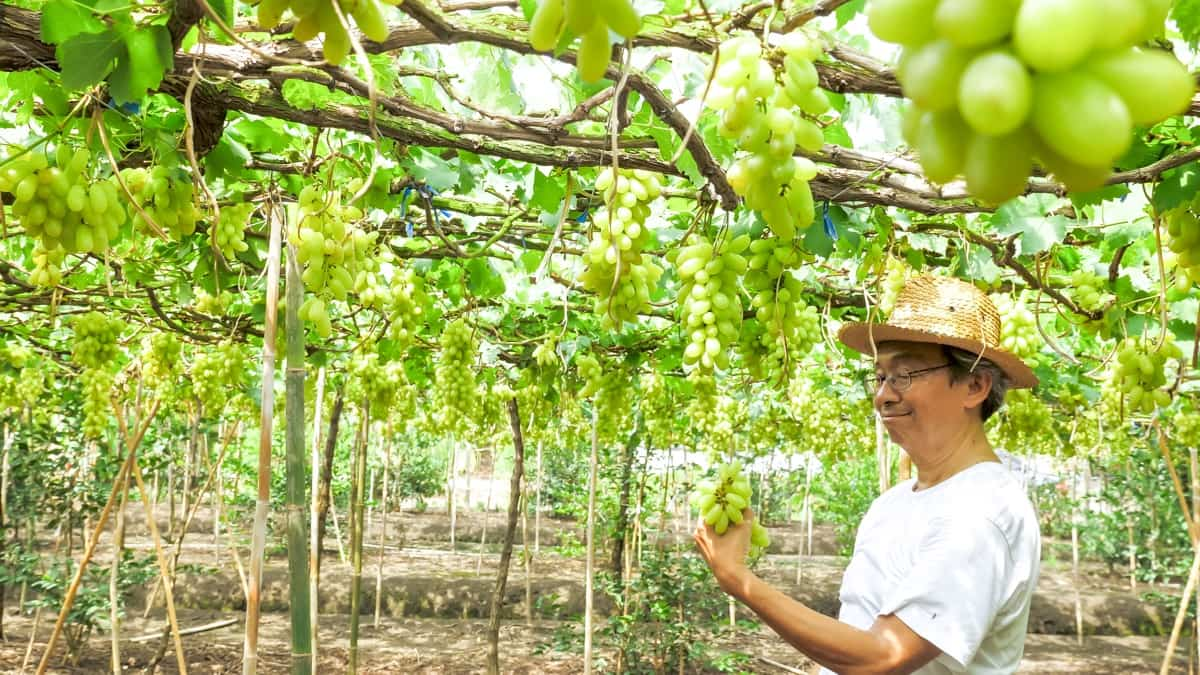
Grape leaf folder
Damage symptoms
- A larva is large enough it folds the leaf, exposing it under the surface; the edge is held in place by bands of silk thread.
- Within the protection of this fold, the larva feeds, skeletonizing the leaf of the upper surface.
- Larvae roll muscadine leaves, which are thinner than bunch grape leaves.
Control methods
Collecting and burning the infested leaves is a simple method to control the pest population.
Diseases in Grapes crop and their organic control
Downy mildew
Disease symptoms
- Lesions appear on infected leaves and gradually turn brown as they age.
- Premature leaf drop is common in severely infected plants.
- Affected petioles, tendrils, and shoots often curl, develop a shepherd’s crook, and eventually die.
Control methods
- Maintain plant vigor. Make sure soils are well drained.
- Remove fallen leaves, which are the source of overwintering inoculum.
- Prune out the ends of infected shoots.
Anthracnose
Disease symptoms
- The disease appears first as dark red spots on the berry.
- Later, these spots are circular, hollow, and ashy-gray; in the late stages, these spots are surrounded by a dark margin.
- The fungus also attacks shoots, tendrils, petioles, leaf veins, and fruit stems. Numerous spots sometimes occur on the young shoots.
Control methods
- Proper dormant pruning and destruction of old canes, clusters, and other plant parts can significantly reduce the number of spores.
- Apply liquid lime sulfur in early spring, just before buds break. The spray kills the initial spores and prevents further development of the disease.
In case you missed it: How to Start Polytunnel Farming: Step-By-Step Guide, Benefits, Types, and How to Build Polytunnel
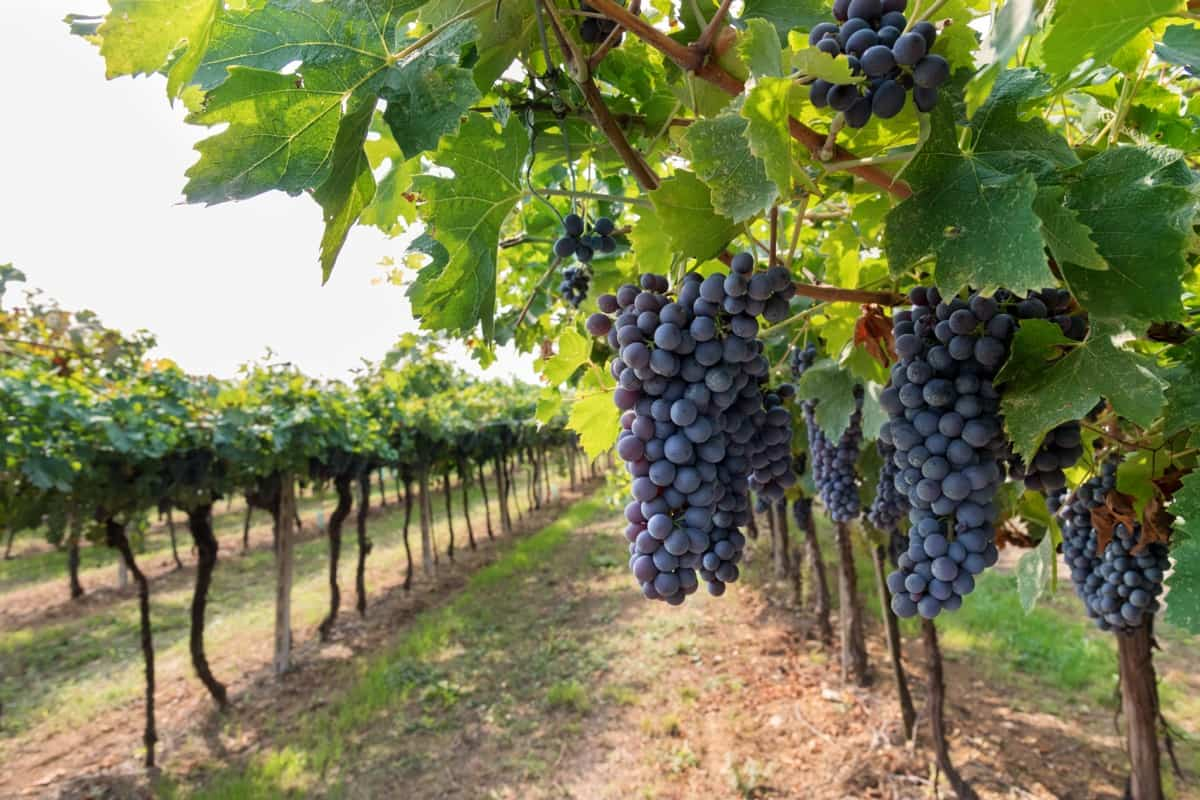
Botrytis bunch rot or gray mold
Disease symptoms
- Berry stems and cluster stems may be invaded, causing them to fade.
- When the fungus decays, berries are low in sugar, and rotting berries taste sour.
- If the berries are nearly mature and have a high sugar content, the decaying berry is quite firm, dry, and somewhat sweet.
Control methods
- Improve air circulation between plants by pruning or staking them.
- Add a good amount of organic compost or mulch under plants. Mulches prevent the fungal spores from splashing back onto flowers and leaves.
Harvesting Grape crop
Nearly one million tonnes of grapes are harvested all over India annually. Notably, the harvest period depends on the variety and clone type, while growers should keep in mind that berries start ripening doesn’t mean that they’re ready for harvesting. Almost all varieties need to be harvested once their color changes near the tip and taste sweet. For example, Anab-e-Shahi or Thompson Seedless and its hybrids contribute a huge part and are harvested during March-April in the hot tropical region.
In case you missed it: How to Get Rid of Fruit Fly in Vegetables: Symptoms, Treatment, Management, Chemical, and Organic Control
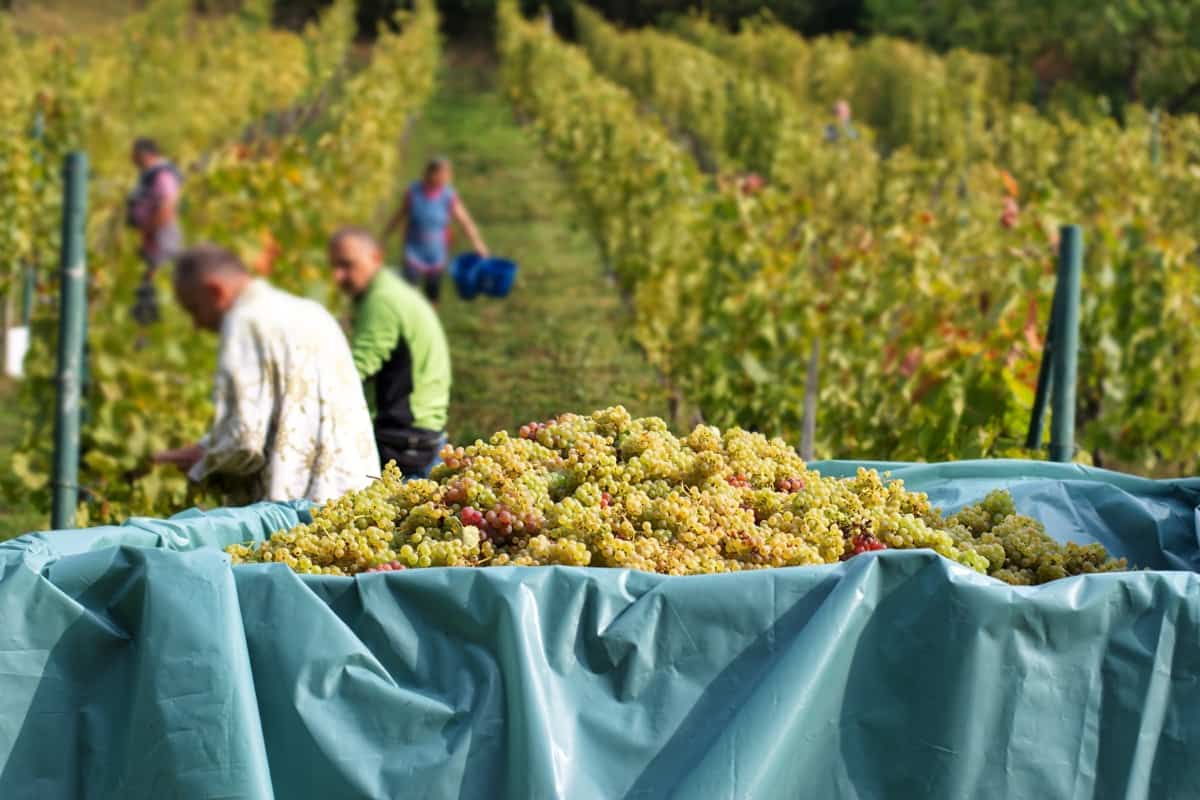
On the contrary, it is harvested during July and Nov-Dec in the mid-tropical region. Similarly, Bangalore Blue is harvested in Jan-Mar and June-Dec, whereas Gulabi’s harvesting period is Jan-Mar and June-Dec. Remove the decayed, deformed, smashed, or undersized berries from clusters a day before harvesting.
Morning is the best period for harvesting. According to varieties and geographical location, yield also varies. For example, the average yield of Bangalore Blue is 16-20 tons/acre, and Anab-e-Shahi offers 20-24 tons/ha, while Gubali growers can expect 12-20 tons. The yield may range between 10-16 tons/acre for seedless types like Thompson Seedless.
Conclusion
A vineyard is a very labor-intensive farming business. Much work is done by hand and in hot and humid weather. Nevertheless, the cultivation of grapes is highly profitable, and there is a good scope for tapping export opportunities by adopting good farm practices in raising the crop.
- How to Make Houseplants Bushy: Effective Tips and Ideas
- Innovative Strategies for Boosting Coconut Pollination and Yield
- Pollination Strategies for Maximum Pumpkin Yield
- The Complete Guide to Chicken Fattening: Strategies for Maximum Growth
- Natural Solutions for Tulip Problems: 100% Effective Remedies for Leaf and Bulb-Related Issues
- Revolutionizing Citrus Preservation: Towards a Healthier, Greener Future
- Natural Solutions for Peony Leaf and Flower Problems: 100% Effective Remedies
- Maximizing Profits with Avocado Contract Farming in India: A Comprehensive Guide
- Natural Solutions for Hydrangea Problems: 100% Effective Remedies for Leaf and Flowers
- The Ultimate Guide to Choosing the Perfect Foliage Friend: Bringing Life Indoors
- From Sunlight to Sustainability: 15 Ways to Use Solar Technology in Agriculture
- The Ultimate Guide to Dong Tao Chicken: Exploring from History to Raising
- The Eco-Friendly Makeover: How to Convert Your Unused Swimming Pool into a Fish Pond
- Mastering the Art of Delaware Chicken Farming: Essentials for Healthy Backyard Flocks
- 20 Best Homemade Fertilizers for Money Plant: DIY Recipes and Application Methods
- How to Craft a Comprehensive Free-Range Chicken Farming Business Plan
- Brighten Your Flock: Raising Easter Egger Chickens for Beauty and Bounty
- How to Optimize Your Poultry Egg Farm Business Plan with These Strategies
- Subsidy for Spirulina Cultivation: How Indian Government Schemes Encouraging Spirulina Farmers
- Ultimate Guide to Raising Dominique Chickens: Breeding, Feeding, Egg-Production, and Care
- Mastering the Art of Raising Jersey Giant Chickens: Care, Feeding, and More
- Ultimate Guide to Raising Legbar Chickens: Breeding, Farming Practices, Diet, Egg-Production
- How to Raise Welsummer Chickens: A Comprehensive Guide for Beginners
- How to Protect Indoor Plants in Winter: A Comprehensive Guide
- Ultimate Guide to Grow Bag Gardening: Tips, Tricks, and Planting Ideas for Urban Gardeners
- Guide to Lotus Cultivation: How to Propagate, Plant, Grow, Care, Cost, and Profit
- Agriculture Drone Subsidy Scheme: Government Kisan Subsidy, License, and How to Apply Online
- Ultimate Guide to Raising Araucana Chickens: Breed Profile, Farming Economics, Diet, and Care
- Bringing Hydroponics to Classroom: Importance, Benefits of Learning for School Students
- Ultimate Guide to Raising Polish Chickens: Breed Profile, Farming Economics, Diet, and Care
- Ultimate Guide to Raising Australorp Chickens: Profile, Farming Economics, Egg Production, Diet, and Care
- Silkie Chicken Farming: Raising Practices, Varieties, Egg Production, Diet, and Care
- Sussex Chicken Farming: Raising Practices, Varieties, Egg Production, Diet and Care
- Homemade Feed Formulations for Livestock: Discover Cost-effective Starter to Finisher Feed Recipes
- 20 Best Pig Weight Gain Supplements: Top Swine Weight Gain Formulas
- Ultimate Guide to Elderberry Farming: Propagation, Planting, Yield, Cost, and Profit